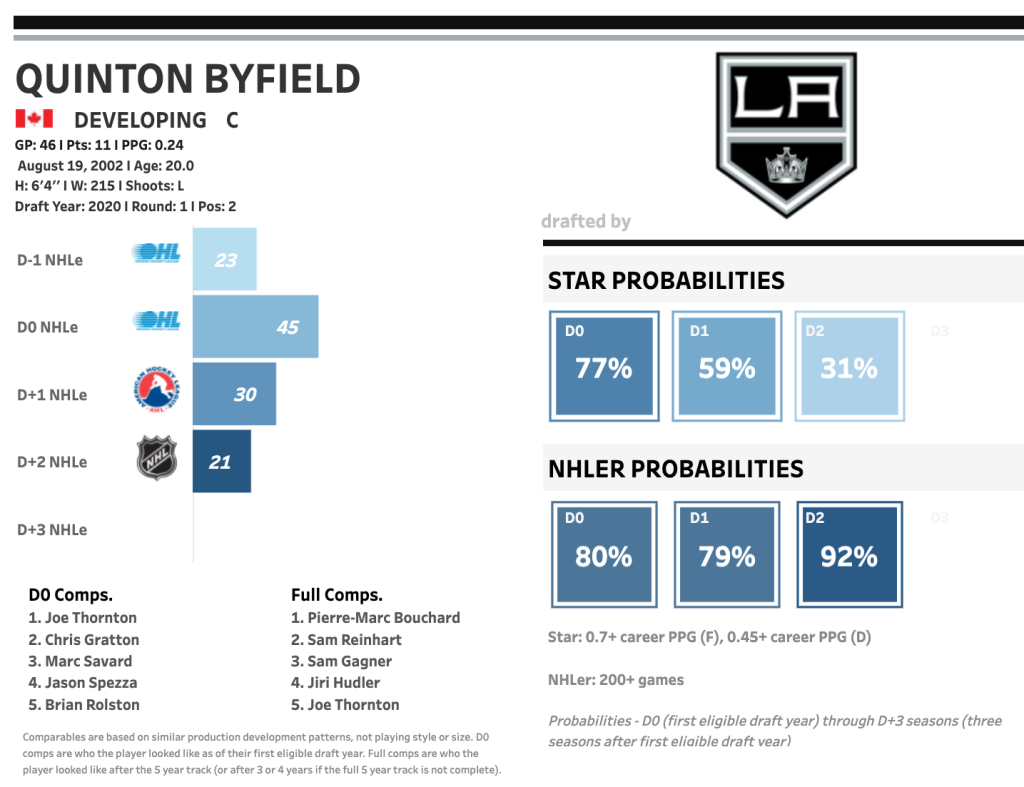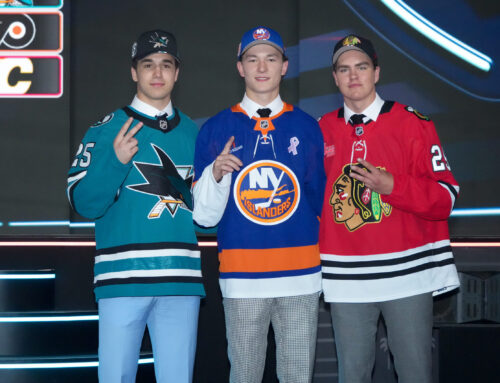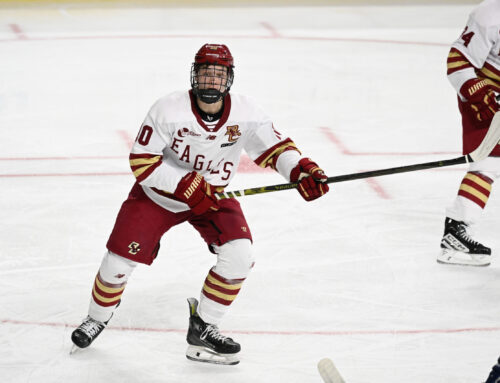Welcome back to The Journey, where we follow hockey prospects and their paths to the NHL, providing fantasy predictions and analysis along the way.
Fantasy managers have short memories when it comes to young players and prospects. We know this about ourselves. We become intoxicated by "the next big thing" with every new draft class. The next shiny toy.
But when our can't-miss, first-overall pick with generational comparables is still scoring at a sub-60-point pace four years later (Nathan MacKinnon), it is hard not to panic and trade them while they still have some name value—ie. selling low. The fear in fantasy is refusing lavish offers for your first overall pick and then drafting a Nolan Patrick or Nail Yakupov and watching your significant asset slowly evaporate. The fear is real.
The smart play is of course to buy low. Just trade for MacKinnon at the end of his fourth year right before he starts consistently pacing for over 100 points. At that point, his value was miles lower than both when he was drafted and the following year when he became dominant.
As frequent readers of this column are well aware, one key to buying low at the right time is understanding and utilizing Breakout Thresholds—a rough measure (80% accurate) to help predict when players will break out and show their upside, which is generally at least 25% greater than what they have done up to that point.
As Dobber explains, "average-sized forwards (between 5-10 and 6-2, or between 171 and 214 pounds) need 200 NHL regular season games to figure it out. At that point, they should show what they will be when fully developed.” He further clarifies that "fully developed" isn’t the same as peaking and more like the beginning of a player’s prime production years. Players that are smaller or bigger than those height/weight guidelines tend to take twice as long, 400 games, to hit their BT.
MacKinnon is actually an interesting example because he took 300 games to break out even though he is average sized. Even if you knew about the BT theory, you were likely nervous watching him still chugging along at a 55-point pace at the end of 2016-17, 100 games after he was "supposed to" be doing more. A more recent example is Nico Hischier, also an average-sized former first overall pick, who broke out halfway through last year around his 265th game to start putting up point-per-game numbers after four seasons in the 40s and 50s. Both players belong to the 20% of players who the BT theory fails to predict accurately.
But there were other contextual factors that signalled a breakout was still coming for both MacKinnon and Hischier. The 2016-17 Avalanche, for instance, finished last in the league by an insane 21 points that year. MacKinnon also sported a low 5-on-5 shooting percentage, had poor puck luck (985 PDO), and still drove play very effectively against tough competition despite the lack of elite production—2021-22 Jesse Puljujarvi, anyone?
Similarly, the 2020-21 Devils had a horrible year, finishing third last in the league and struggling to put everything together. Hischier was injured for most of that year and never really got back up to speed. As his case exemplifies, injuries are a common reason for a player's BT being delayed.
By the way, Frozen Tools makes it easy to quickly scan the league for who is approaching their BT. Click "more stats" and then "Next year breakout" under the Advanced Stats tab. Here are a few interesting players who should hit their BTs next year:
Jason Robertson – 128 GP
Jack Hughes – 166 GP
Josh Norris – 125 GP
Adam Boqvist – 128 GP
Kaapo Kakko – 157 GP
Carter Verhaeghe – 173 GP
Noah Dobson – 160 GP
Jordan Kyrou – 173 GP
Victor Olofsson – 188 GP
Drake Batherson – 145 GP
Dillon Dube – 200 GP
Filip Zadina – 160 GP
Dante Fabbro – 174 GP
Eeli Tolvanen – 122 GP
Max Comtois – 146 GP
Ryan Lindgren – 194 GP
Players just past the 200-game mark who may have hit their BT at the end of last season include:
Jesperi Kotkaniemi – 237 GP
Devon Toews – 235 GP
Filip Hronek – 245 GP
Mathieu Joseph – 232 GP
Henri Jokiharju – 213 GP
Nolan Patrick – 221 GP
Let's dig in a little further into a couple of the names on these lists, as well as a couple players who are not due to break out for another five (!!!) seasons.
After Hughes scored 112 points in 50 games with USDP in his draft year, people were over the moon about him. Expectations were sky high. Many thought he would walk into the league on a terrible team and keep putting up gaudy numbers like that at the top level as a skinny 18-year-old.
Surprise, surprise, there was an adjustment period as Hughes acclimated and matured and the team around him slowly figured things out and acquired more assets. Heading into 2022-23, people are obviously excited about him again after he paced for 94 points in 2021-22 as a 21-year-old. But there was a brief buy-low window after Hughes paced for 28 and 45 points over his first two years in the NHL, and that is where the short memory angle comes in.
At the end of 2020-21, when the Hughes owner in your league was becoming restless, that fear growing larger in the back of their mind that he was no longer on track to superstardom—-that was the time to pounce. He was probably still fairly expensive given his pedigree but certainly much cheaper than he would be to acquire now. He is going to hit his BT halfway through this coming campaign, so the sky is the limit for this guy.
Unlike with Hughes, the window is still wide open to buy low on Kakko, the second overall pick in 2019. Despite gaining some traction as part of "The Kid Line" during the Rangers' most recent playoff run, he still only contributed five points over 19 playoff games and his value is basically in the gutter in fantasy circles despite his pedigree—again, because we have short memories.
He has scored at a paltry 30-point pace over his career thus far. He averages under 16 minutes per game and has never featured prominently on New York's power play. He barely shoots the puck (1.4 shots per game) or hits (eight total in 2021-22) and is not involved often enough in goals scored while he is on the ice (53% IPP). Tons of red flags you can bring up in trade negotiations to lower his price even further.
But Kappo is due to break out halfway through 2022-23, and his chart actually looks a lot like Jesse Puljujarvi's—he does not drive play quite as well as the Edmonton winger and gets fewer offensive zone starts (for now), but he has been doing a fantastic job in the Rangers' top six playing against tough competition.

Kakko is an effective two-way forward who consistently plays with New York's top players—he played 71% of the time with some combination of Chris Kreider and Mika Zibanejad or Ryan Strome and Artemi Panarin last year. The only notable switch during the off-season has Vincent Trocheck in the 2C role instead of Strome, so his role is secure.
He just needs to start shooting the puck more, which was a big part of his success in Finland during his draft year when he scored an incredible 38 points in only 45 Liiga games, including 22 goals. He is a big guy (6-3, 205 lbs) but hits almost as infrequently as someone like Quinn Hughes or Clayton Keller, so Kakko needs to increase his point and shot totals and claw his way into meaningful power play time to become relevant in fantasy.
There is also an outside chance that Kakko is close enough to being exceptionally sized that he will require an additional 200 games to fully reach his upside. Either way, now is still the time to make a move on him because it is hard to imagine his stock falling lower than it is currently. Even if his proper breakout takes another year or three, he will likely still show steady improvements moving forward. Dobber has him pencilled in for 36 points in 66 games in 2022-23 in the Fantasy Guide but is bullish on his eventual 95-point upside—for reference, that is the same as his prediction for Marco Rossi and Quinton Byfield and five points higher than Trevor Zegras and Alex Newhook.
Get your copy of the Guide here. It is an incredible resource; much more informative and useful than the fantasy magazines you will find for the same price on newsstands.
Hopefully you let someone else grab Slafkovsky after he surprisingly went first overall in 2022. That doesn't mean he won't become a great player—he could become an absolute beast in fantasy down the road—but he qualifies as an exceptionally sized forward (6-4, 218lbs) and should take 400 NHL games to reach his BT.
Let's say he takes a year or two to make the NHL full time and then another basically five seasons to log his 400 games. That means Slafkovsky is on track to hit his upside during the 2030-31 season, 2028-29 if he makes the Canadiens right away. Let that sink in for a moment. Even the most hardcore prospect nerd undergoing the most thorough rebuild in the deepest dynasty should hesitate over a timeline like that.
But if you let someone else grab Slafkovsky, you're in a wonderful spot. You can just carry on running your team, rebuilding, contending, whatever you're doing, and then three or four seasons into his NHL career you can try to buy low. Maybe he'll have averaged 40 points a year over his first 300-odd games. He'll be a lot cheaper at that point than he is right now.
Byfield is a player I'm salivating over in leagues where I don't own him yet. He of course went second overall in 2020 after Alexis Lafreniere and is projected to become a superstar pivot. He is even bigger than Slafkovsky (6-5, 220 lbs) but skates better and is on track to reach his 400-game BT in just under four and a half seasons, partway through 2026-27.
His owners have already started getting restless in some of my leagues. Here's why:

By all appearances, his arrow is pointing straight down. So is Byfield going to become Sam Gagner?!? No. No he's not.
It is all relative to specific leagues and managers, of course, but Byfield's price has likely already dropped significantly in the two years since he was drafted. After a freak injury at the start of last year, he only played 40 games in 2021-22, with just over 12 minutes per night, and scored at a lowly 21-point pace. He has not yet exploded or taken a significant step forward and, as we have established, that probably will not happen for a number of years still. Many managers are going to become increasingly impatient and fearful about the status of their valuable investment.
But if you are aware of his projected timeline, and you know about his top-notch pedigree and ever-improving team situation, you can continue to calmly value Byfield properly and either sit on him or pitch deals to acquire him accordingly as his BT approaches down the line.
Thanks for reading! Follow me on Twitter @beegare for more prospect content and fantasy hockey analysis.






 UTA
UTA ANA
ANA MIN
MIN CAR
CAR MTL
MTL NYI
NYI VGK
VGK DET
DET L.A
L.A
